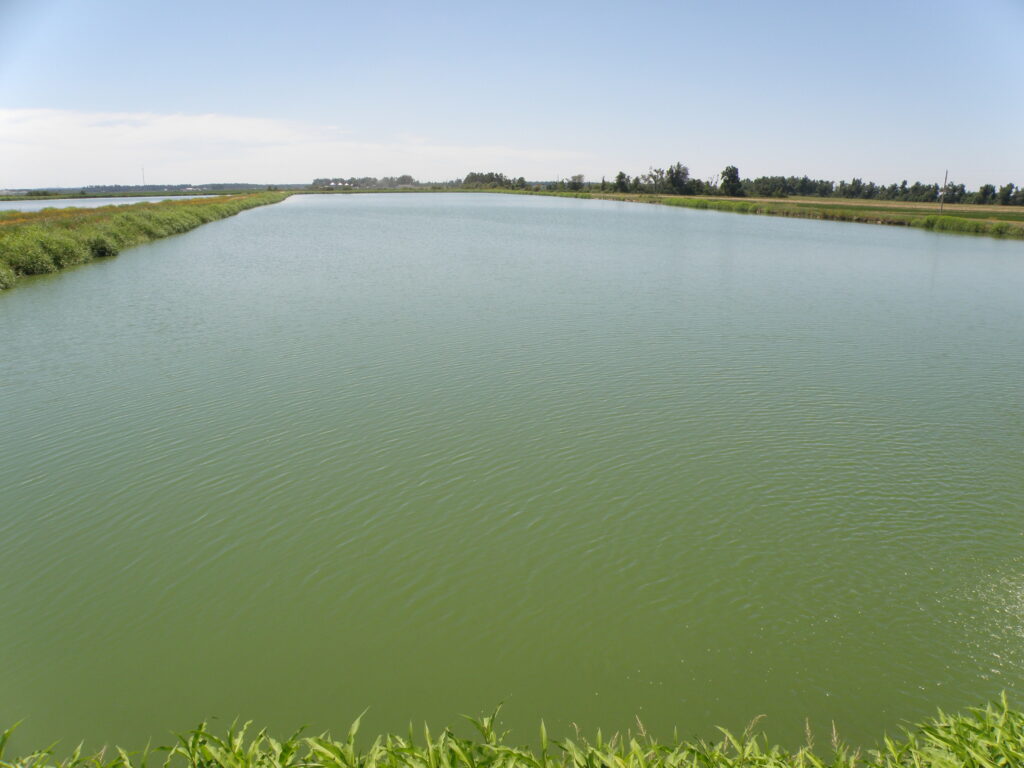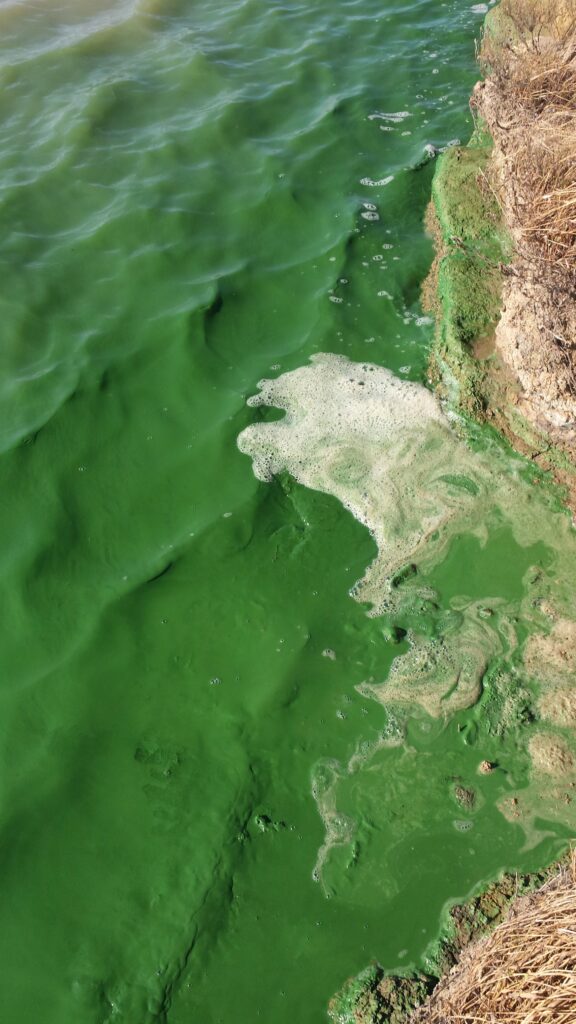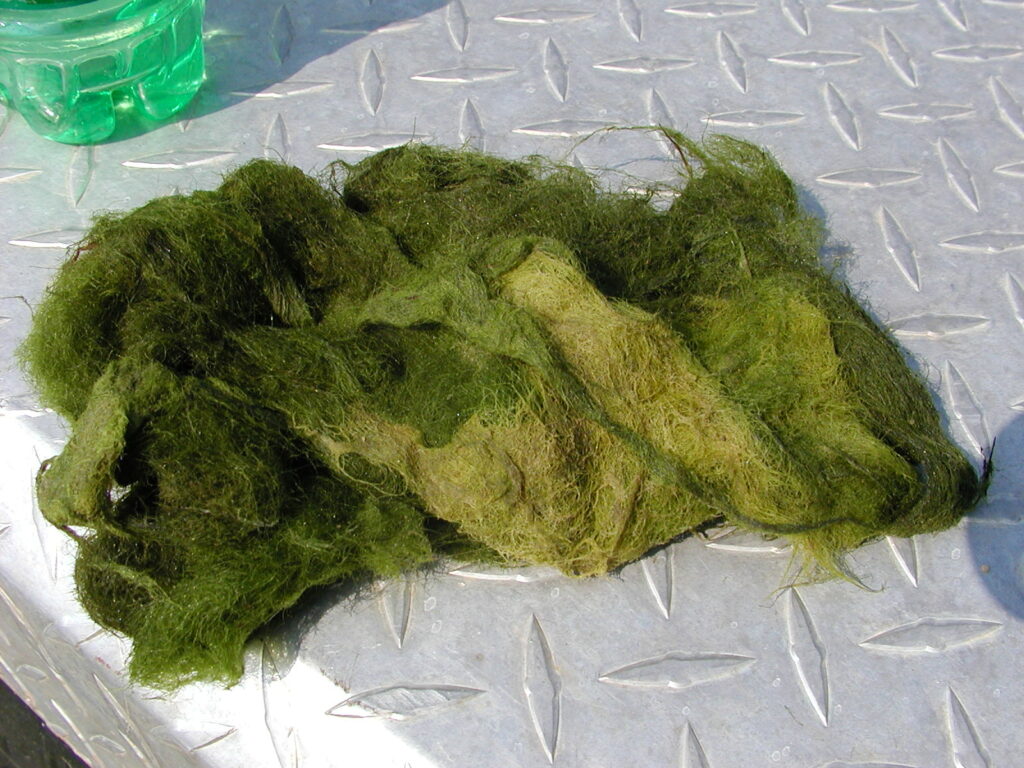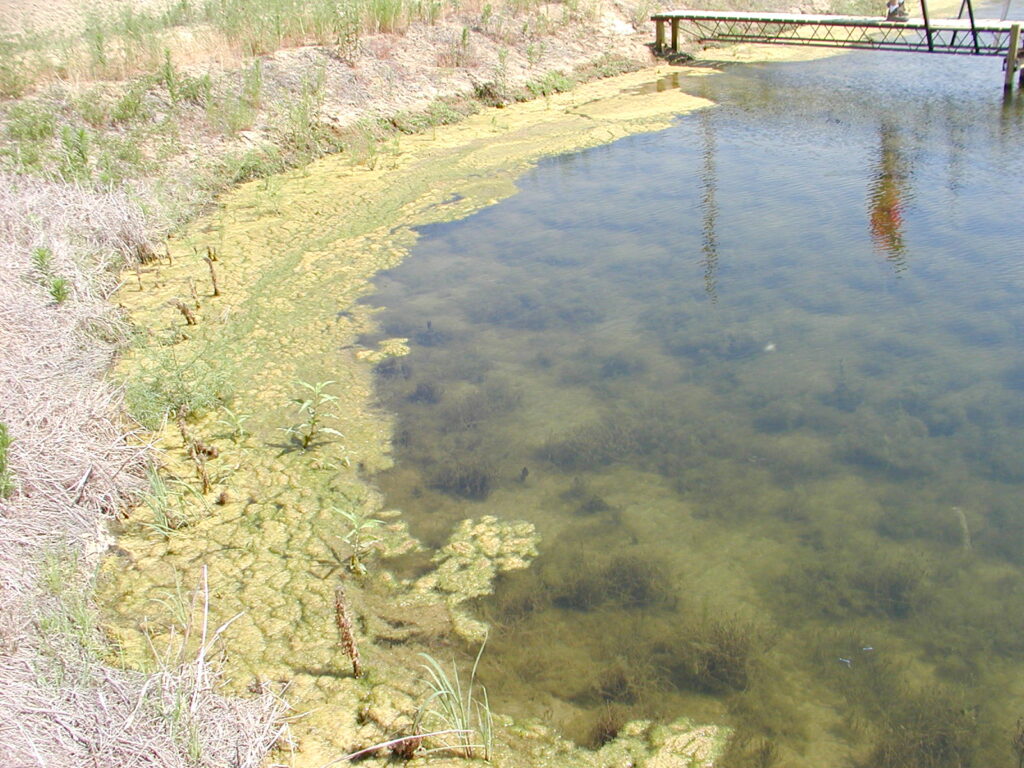Algae Control in Ponds
go.ncsu.edu/readext?1069856
en Español / em Português
El inglés es el idioma de control de esta página. En la medida en que haya algún conflicto entre la traducción al inglés y la traducción, el inglés prevalece.
Al hacer clic en el enlace de traducción se activa un servicio de traducción gratuito para convertir la página al español. Al igual que con cualquier traducción por Internet, la conversión no es sensible al contexto y puede que no traduzca el texto en su significado original. NC State Extension no garantiza la exactitud del texto traducido. Por favor, tenga en cuenta que algunas aplicaciones y/o servicios pueden no funcionar como se espera cuando se traducen.
Português
Inglês é o idioma de controle desta página. Na medida que haja algum conflito entre o texto original em Inglês e a tradução, o Inglês prevalece.
Ao clicar no link de tradução, um serviço gratuito de tradução será ativado para converter a página para o Português. Como em qualquer tradução pela internet, a conversão não é sensivel ao contexto e pode não ocorrer a tradução para o significado orginal. O serviço de Extensão da Carolina do Norte (NC State Extension) não garante a exatidão do texto traduzido. Por favor, observe que algumas funções ou serviços podem não funcionar como esperado após a tradução.
English
English is the controlling language of this page. To the extent there is any conflict between the English text and the translation, English controls.
Clicking on the translation link activates a free translation service to convert the page to Spanish. As with any Internet translation, the conversion is not context-sensitive and may not translate the text to its original meaning. NC State Extension does not guarantee the accuracy of the translated text. Please note that some applications and/or services may not function as expected when translated.
Collapse ▲Combine water, sunlight and nutrients, and some form of plant growth will result. Whether it is algae, rooted aquatic plants, floating plants or some combination of these, something will grow in the water. Perfectly clear water in a pond, with no plant growth of any type, occurs only under rare or unnatural conditions.

Pond with “Bloom”
Algae in the form of microscopic plants are called “phytoplankton” and come in a wide variety of shapes and forms. Some forms of phytoplankton can actually move, using active propulsion methods such as whip-like tails (flagella) or through regulating the amount of gas in their cells. Diatoms, golden-brown and green algae, are common during the winter and spring. Blue-green algae (Cyanobacteria) often become the dominant type of algae in nutrient-enriched waters during warmer months. Blue-greens are generally considered undesirable for a variety of reasons. Certain blue-greens form unsightly surface films or scums (sometimes resembling a layer of green paint). They can be prone to sudden die-offs, and some species release compounds that give fish a muddy or musty flavor. In addition, a number of species of blue-green algae can produce toxins under certain conditions.

Cyanobacteria
When algae populations are dense enough to turn the water a green or greenish brown color they are referred to as a “bloom.” Problem blooms can occur in the summer months and are more frequent in times of drought.
Bloom density in pond water can be measured using a Secchi disk. A Secchi disk is nothing more than a circular flat disk, typically 8 inches in diameter, made from wood or plastic and painted white or with black and white quadrants. The disk is mounted on a yardstick. The cut-off bottom of a plastic bleach bottle works well, and the yardstick can be fastened to the handle. To use the disk, insert it upright in the water and lower until the circular disk just disappears from view. Read the water depth on the yardstick. Slowly raise the disk until it can be seen again, and read the depth again. The average of the two readings is the “Secchi depth.” Infertile water bodies should have Secchi depths of greater than 3 feet. In nutrient rich ponds, a Secchi depth in the range of 18 to 24 inches (during the summer months) is ideal. Blooms are considered to be too dense when the Secchi depth is less than 12 inches.

Secchi Disk
Filamentous Algae
Filamentous algae are single algae cells that form long visible chains, threads, or filaments. These filaments intertwine forming a mat that often resemble wet wool. Filamentous algae start’s growing along the bottom in shallow water or attached to structures in the water (like rocks or other aquatic plants). Filamentous algae will often detach from the pond bottom and float to the surface, forming large mats. There are many species of filamentous algae and often more than one species will be present at the same time in the pond.

Pithophora

Pithophora
Mechanical Control
Raking out the vegetation is burdensome, time consuming, and disposal can be difficult, but possible in some cases.
Physical Control
To help control aquatic plant growth, attempts should be made to limit the amount of phosphorus entering any water body. Livestock should be prevented from entering the pond if at all possible. If desired, excess phosphorus can be inactivated by using alum, Phoslock®, or other similar product. This will not control current growth. If the pond is regularly fertilized (like a recreational carp pond) it should not be tried.
For pond areas below three feet, the use of an aquatic dye, applied during the winter or early spring, could limit growth of filamentous algae by reducing light penetration. Phytoplankton growth will be unaffected.
Biological Control
Tilapia stocked at a rate of 60 lb/acre can sometimes control filamentous algae. The negatives associated with stocking tilapia include availability, predation due to Largemouth Bass, and eventual mortality due to cold temperatures (below 70F) in the fall.
Tilapia are also a non-native species. Since permanent establishment of non-native plant and animal species is undesirable, care should be taken to ensure that the intended water body does not have areas that stay warm enough (such as a thermal spring) during the winter which could allow some fish to survive.
Chemical Control
Excellent– Copper sulfate and copper complexes
Good to Excellent– Sodium Carbonate Peroxyhydrate, Flumioxazin
Good– Diquat*, Endothall (Hydrothol formulation)
*Control can be sometimes enhanced by combining diquat with copper sulfate/copper complexes
Copper sulfate and Copper complexes
- Causes cells to leak
- The effectiveness and safety of copper sulfate treatments are mostly determined by water alkalinity
- At water alkalinity <40ppm, copper sulfate treatments can be toxic to fish.
- In water with alkalinity >250-300ppm, the copper sulfate binds quickly with carbonate, rendering it ineffective.
- Amount of Copper Sulfate needed =
[Total Alkalinity (ppm) /100] x Recommended Dose (ppm) x Volume (in acre*ft) x2.72
- Alkalinity <20ppm, use chelated form or avoid copper products altogether
- Some evidence exists that the chelated formulations might be more effective against algae than dissolved copper sulfate crystals alone.
- Copper sulfate can be tank mixed with: diquat, endothall, flumioxazin (for algae)
Aquatically labeled Brand Names: What follows is a listing of aquatically labeled herbicides that can be effective on algae. This is designed to hopefully make it easier to find a suitable product for the pond manager. It should not be assumed that this list is complete.
Copper Sulfate Crystals & Granules:
Old Bridge Copper Sulfate Fine, AquaVet Copper Sulfate Algae Control, SePRO Total Pond- Clear G, Gordon’s Pondmaster Copper Sulfate Crystals, Copper Sulfate Crystals- Chem One, AB Brand Copper Sulfate Crystals, AquaVet Algae Control, Lake Guard Blue, SeClear G, Quimag Quimicos Aguila Copper Sulfate Crystal, Aqua Hawk Cu, Blue-Stone Crystals, Crystal Blue Copper Sulfate Smart Crystals
Copper Sulfate Solution:
Gordon’s PondMaster SeClear Algaecide & Water Quality Enhancer Ready-To-Use, SeClear Algaecide- SePro, Liquid Copper Sulfate, AgriTec, Earthtec, Stock Plex Stock Tank Algae Control, Main Stream 635 Algaecide/Bactericide, SeClear Algaecide & Water Quality Enhancer Ready-to-Use, TMB-471C, EarthTec QZ, Pond Boss Pro, Crystal Plex Algae Control, SCI-62 Algicide/Bactericide, Current, Pond Champs Algae X Algaecide/Herbicide, Formula F-30 Algae Control, SePRO Total Pond-Clear,
Copper Complexes (Copper Ethanolamin, Copper Carbonate, etc.):
Algimycin-PWF Algaecide/Cyanobacteriocide- Applied Biochemist, Cutrine Ultra- Applied Biochemist, Cutrine Plus Algaecide/Herbicide- Applied Biochemist, CutrinePlus Granular Algaecide- Applied Biochemist, Stocktrine II Algaecide, Algi-Cure Algaecide- Applied Biochemist, Harpoon Aquatic Herbicide, Clearigate- Applied Biochemist, Gordon’s Pondmaster Aquatic Herbicide, Captain Liquid Copper Algaecide, K-Tea Aquatic Herbicide, Komeen, Nautique Aquatic Herbicide, Algae Defense, Captain XTR, Harpoon Granular Aquatic Herbicide, Symmetry NXG, Mizzen Algaecide, Komeen Crystal, Argos, Pond Oasis Algaecide, Cutrine Plus Algaecide- Applied Biochemist, Nalco 2877, Clearigate EC9- Applied Biochemist, Cutrine Plus- SePro, Cutrine Plus Granular- SePro, Algi-Cure- SePro, Cutrine Ultra- SePro, Clearigate- SePro, Harpoon Aquatic Herbicide- SePro, Harpoon Granular Aquatic Herbicide- SePro, Algimycin PWF- SePro
Flumioxazin
- Very sensitive to pH
- at pH9 – the half-life is minutes
- Buffer tank mix so pH is <7
- Apply in early morning
- Flumioxazin can be tank mixed with: copper, diquat, endothall
Aquatically labeled Brand Names:
Clipper- Valent, Flumioxazin 51% WDG-NonCrop, Clipper SC Aquatic Herbicide- NuFarm, Pond-Klear Aquatic Herbicide, Semera 51% WDG, Flumioxazin 51WDG Select, Semera SC, Joya Non-Crop Herbicide, KnockDown Defense Algae & Aquatic Weed Control, Schooner 51.0% WDG, Schooner SC
Sodium Carbonate Peroxyhydrate (SCP)
- SCP is only effective against algae
- SCP converts to hydrogen peroxide when applied to water
- Hydrogen peroxide is a powerful oxidizer and is the compound that causes damage to the plant cells
- Hydrogen peroxide will eventually convert into water, leaving no chemical residue, making it safe for all applications
- It is applied by itself, but can be followed up with other products, like copper sulfate, providing more effective algae control
Aquatically labeled Brand Names:
EcoBlast Contact Granular Algaecide, Cape Furl, Pak 27 Algaecide- Solvay, Phycomycin SCP- SePro, Algae-Off Granular, Applied Biochemist Phycomycin SCP Algaecide/Cyanobacteriocide, Green X Concentrated Granular Algaecide, GreenClean Granular Algaecide, Phycomycin-SCP Algaecide & Oxidizer, PAK 27- SePro, GreenClean Pro
Diquat
- Don’t use in turbid water
- Active ingredient will bind to suspended particles and become inactivated
- Diquat can be tank mixed with: endothall (submersed), copper (submersed)
Aquatically labeled Brand Names:
Aceto Diquat 2L Landscape & Aquatic Herbicide, Alligare Diquat Herbicide, Weedtrine-D Diquat Herbicide- Applied Biochemist, Harvester Landscape & Aquatic Herbicide, NuFarm Diquat 2L Herbicide, NuFarm Diquat SPC 2L, Quick Kill, Solera Diquat Landscape & Aquatic Herbicide, Reward Landscape & Aquatic Herbicide, Elimination, Tsunami DQ, Littora, Tribune Herbicide, RowRunner ATO, Liberator 711, AquaVet Landscape & Aquatic Herbicide, Ultra PondWeed Defense, Pond Oasis Aquatic Plant Control, Verdure-X-Herbicide, SePro Total Pond- React, Dibrox Herbicide, Dessicash L&A Landscape & Aquatic Herbicide, Diquat Water Weed and Landscape Herbicide, Edge, Edger, Capone Desiccant, Harvester, Weedtrine-D- SePro, AquaStrike (w/endothall)
Endothall (Hydrothol formulation)
- Hydrothol formulation can be toxic to fish above 0.3ppm
- Rapid breakdown at water temperature >80F, through bacterial action
Aquatically labeled Brand Names:
Hydrothol 191 Aquatic, Hydrothol 191 Granular, Teton Aquatic Herbicide, EasyKlear Defense 2 in 1 Granular Algae and Aquatic Weed Control
All the products that are effective on algae are classified as contact herbicides. Contact herbicides will cause harm to only those parts of the plant they contact. Contact herbicides also tend to cause rapid injury to treated plants, but require more complete spray coverage of all plant tissue during application. If a contact herbicide is used on submersed algae, the chemical must remain in the treatment area long enough to expose if at a lethal concentration. Since contact herbicides tend to cause rapid plant death, in areas with dense plant populations and warm water, the decomposing plant tissue can lead to a fish kill due to low dissolved oxygen. Care must be taken to treat only 33-50% of a pond or have supplemental aeration available.
Algae will regrow form a single cell. During the growing season, it should be expected that repeat treatments will be necessary. Once some offending filamentous algae is identified, it should be treated.




